The Samsung Galaxy Note 4 Review
by Joshua Ho on October 15, 2014 9:00 AM EST- Posted in
- Smartphones
- Samsung
- Android
- Mobile
- Galaxy Note 4
Battery Life
Battery life is one of the most important aspects of any mobile device, especially because the battery is what defines mobility to begin with. As a result, it’s important to test battery life in a meaningful manner. This requires a repeatable test with standardized conditions, and a range of scenarios that stress different aspects to get the full picture. Most importantly, for tests that have the display on we calibrate the display to 200 nits to ensure that the test doesn’t penalize brighter displays. In the case of the Galaxy Note 4, we see about a 3% gain in battery capacity, so most of the battery life gains should come from higher efficiency.
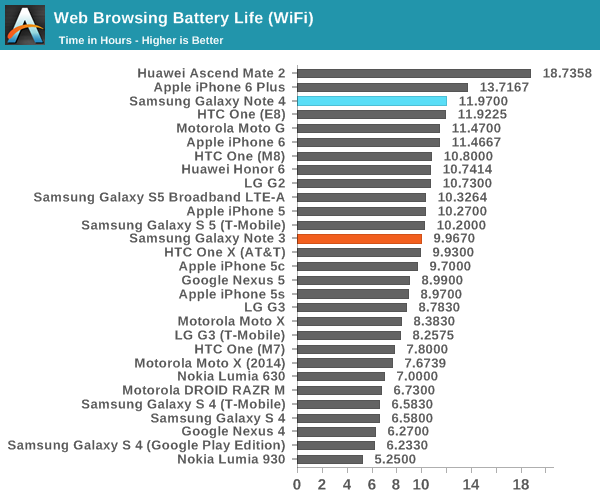
Our first test is the WiFi web browsing test, which loads a given set of web pages in a loop, with special emphasis taken in order to ensure that the test doesn’t penalize faster SoCs, which would have significant effects on our results. As one can see above, the Galaxy Note 4 has a noticeable uplift in battery life when compared to the Galaxy S5 and lasts significantly longer than the Galaxy Note 3. It doesn’t last quite as long as the iPhone 6 Plus, but few people should have issues getting through a full day of intensive use.
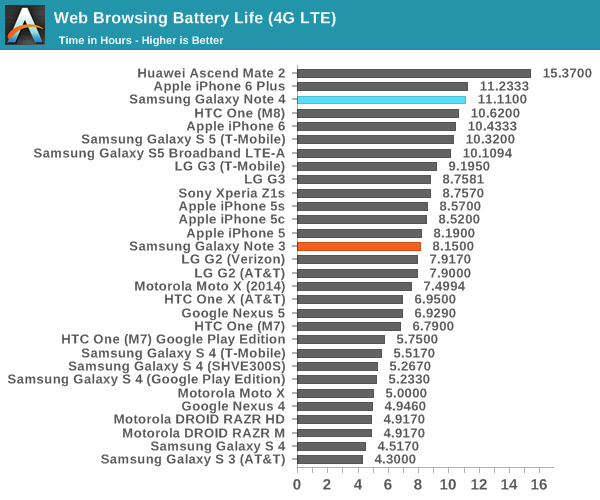
On LTE web browsing, a similar story plays out as the Galaxy Note 4 is able to keep up with the competition and delivers the massive improvement that we’ve generally seen from the transition to Snapdragon 801 and 805.
While the web tests are well-worn by now, we’ve added two additional tests to the battery life suite in order to get a better picture of SoC-bound battery life. To this end, we use an infinite loop of T-Rex on-screen to replicate a GPU-intensive scenario and Basemark OS II’s battery life test to simulate a CPU-intensive scenario.
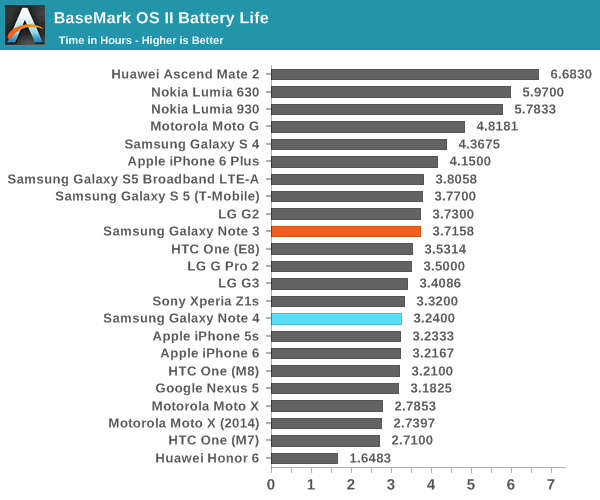
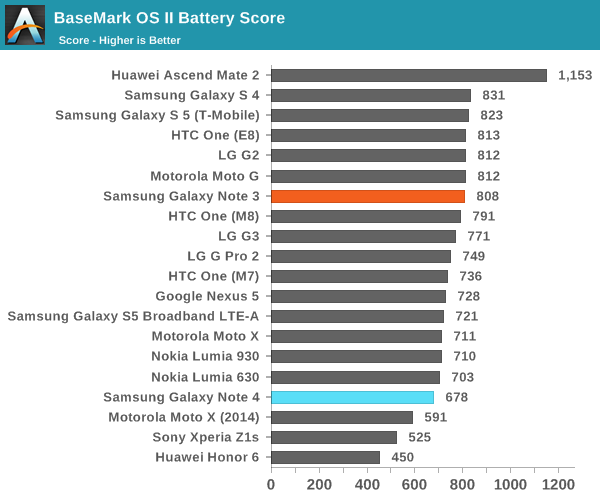
In the case of the Basemark OS II test, we see that battery life under a sustained task ends up a bit lower than we expect, which seems to suggest that in CPU-bound tasks the Note 4 doesn't have much better efficiency when compared to the Galaxy Note 3. This seems to be self-evident, as the CPUs are quite similar and the process technology used is largely similar when comparing the two devices.
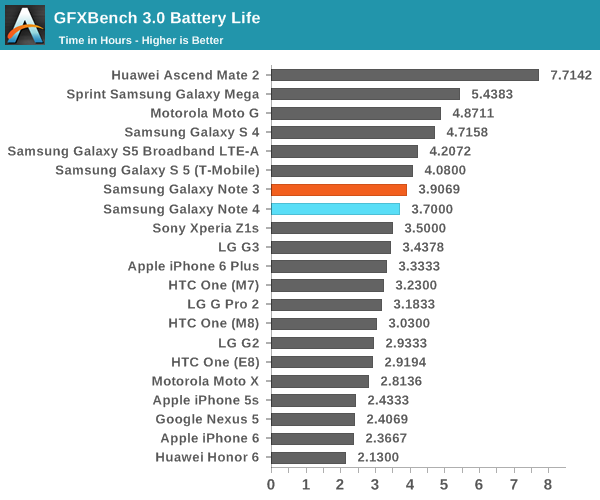
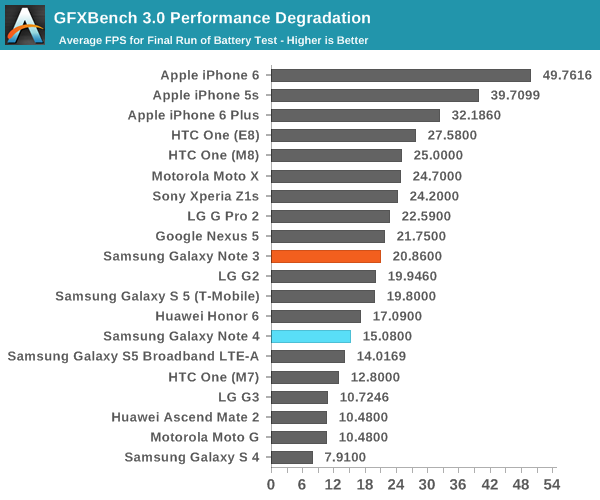
In GFXBench's endless rundown test we see that the Galaxy Note 4 trails behind in battery life when compared to the GS5 LTE-A, but looking at the end of run FPS it’s quite clear that the Galaxy Note 4’s larger surface area makes it possible to achieve greater performance.
Overall, battery life is quite good on the Galaxy Note 4. It’s a massive leap forward when compared to the Galaxy Note 3, but a relatively small one when compared to the Galaxy S5. Once again, we see that most of the benefits in battery life will come from scenarios where power draw isn’t strongly influenced by the display.
Charge Time
As a part of the overall battery life story, it's important to consider the time it takes for a battery to fully charge. If a phone's battery charges slowly then scenarios where charge time becomes crucial will severely hurt real-world battery life. For example, if one forgets to charge their phone at night, the rate at which the phone will charge the battery is a strong influence upon actual battery life. In order to test this, we measure power draw from the time that the device under test is plugged in until it reaches a given level of power draw that indicates that the battery is fully charged.
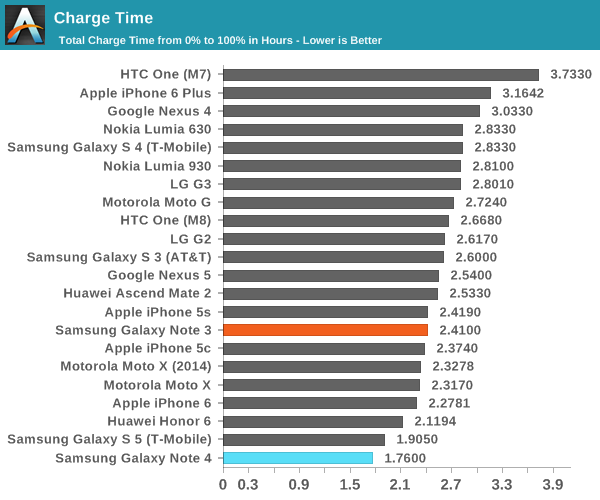
As one can see in the graph above, the adaptive fast-charge mechanism really works, although I don't see a huge benefit when compared to the Galaxy S5's charge time which was already incredibly fast. In the case of the Galaxy Note 4 it seems that it switches between a 9V, 1.64A mode and a 5V, 2A mode as needed, and most of the benefit would come from the first 50% or so of charging as power drops rapidly as the battery approaches full charge.










195 Comments
View All Comments
dunemessiah - Thursday, October 16, 2014 - link
No GPU comparisons to Tegra K1?snake2332 - Thursday, October 23, 2014 - link
Probably because the K1 is considered a tablet-only technology for now, at least until it shows up in a phone/phablet.the snob - Thursday, October 16, 2014 - link
Could Amadtech include a more detailed analysis of the display technology of future phone reviews?I felt that in this regard, reviews from Displaymate trumps Anandtech. But while Displaymate reviews are more specialised and offer much more infomation, their reviews tend to be for popular phones which can generate hits and publicities for themselves. It might be Anadtech's interest to up their depth in this regard.
But other than that, I must say I am enjoying Post-Anand Anandtech as much as before. Good job Joshua, I hope Anadtech will go a long ways in their review contributions.
the snob - Thursday, October 16, 2014 - link
I kept spelling "Anandtech" wrongly, my most sincere apologies! : )edwardjames2014 - Thursday, October 16, 2014 - link
Actually, a lot of people were wrong about big phones. When Samsung first came out with the Note in 2011,I wasn’t the only one who laughed at the idea of a 5.3-inch smartphone. But I was wrong.This is trendency! The Note 4 is the most comfortable large-screened phone, Case for Samsung Galaxy Note 4 htt p://www.ca secoco.com/?031fackamato - Thursday, October 16, 2014 - link
Can we please get the OnePlus One in the charts as well?tralalalalalala40 - Saturday, October 18, 2014 - link
vapor phones? who cares about a phone with 10k users worldwide?Phantasmal - Thursday, October 16, 2014 - link
Is there the latency shot charts/graphs in the article because I don't seem to see them. Thanks.SydneyBlue120d - Thursday, October 16, 2014 - link
I'd like to know more about audio quality and about the MDM9x35 real world performance. Thanks.heartinpiece - Thursday, October 16, 2014 - link
Will you be reviewing the Exynos version as well?If i'm not mistaken, it sports a A53+A57 (but running 32bit Android)